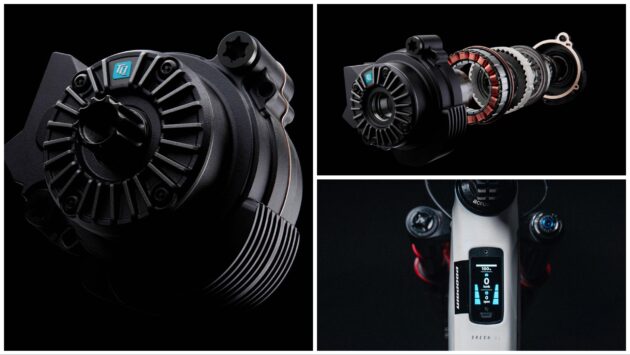TQ's new HPR60 adds 10Nm more torque, and 50W more power, but it's still the smallest, lightest, and quietest system around.
TQ has a new motor – it’s called the HPR 60, and as the name suggests, it adds power and torque over the original three year-old HPR 50. Hopefully addressing the weakest link in a system that was remarkable for its compact size, light weight, and whisper-quiet operation, TQ clearly believes there is still demand for a mid-power system in the face of a power arms race from the likes of DJI, Bosch, and Specialized. Remember, TQ was one of the first brands to come out with an extremely high-power e-bike motor, way back in 2019, with the HPR120S fitted to the Haibike Flyon. It was a motor that packed 120Nm of torque, and essentially used the same harmonic pin ring technology as the HPR60, so the German brand is choosing to persevere with the mid-power motor rather than compete directly with the likes of DJI.

The most obvious visual difference with the new TQ HPR60 motor is the larger cooling fins.
TQ HPR60 need to know
- Torque increases to 60Nm over the original HPR50
- Power up by 50W to a maximum 350W, with up to 200% rider assistance
- 350W peak power available from cadence of 55rpm
- Improved cooling including larger exterior fins
- Increased efficiency
- New hi-res colour display with additional functionality
- 580Wh, 360Wh, 290Wh battery options plus 160Wh range extender

An exploded HPR60 motor gives an insight into the complexity and tight packaging.
Addressing the HPR50’s lack of range
We’ve tested multiple TQ-powered e-bikes since it was launched, from the original Trek Fuel EXe to the Canyon Spectral:ONFly and Mondraker Neat, and found that the biggest problem with all those bikes was the lack of range. This was highlighted in our range test featuring all the best mid-power motors fitted to 8 of the hottest SL e-bikes. In that test the Trek came plumb last, with just 811m climbing in the most powerful mode available. An even bigger problem for the TQ was that the HPR50 was so underpowered, that you needed the high power modes to get any worthwhile assistance.

TQ can still claim the lightest, most minimal motor on the market.
With the new 580Wh battery, range anxiety is no longer a worry. I’ve been testing a Trek Slash+ with the HPR50 and the 580Wh battery inside for months now, and regularly achieve over 1,300m of climbing in the mid power mode, and that’s on an enduro bike with soft tyres and a draggy high-pivot idler transmission. Of course, the new HPR60 has more power, so you’d expect it to cover less ground all things being equal, but on the new Yeti MTE launched today – and another as-yet-unreleased bike – I’ve still managed to easily achieve over 1,400m climbing in Mid and High power modes.

Yeti’s new MTE is one of the first new bikes with the HPR60 drive system.
Extra power and torque – more than than the numbers suggest
So range is no longer a worry. But what about power? On paper the new system doesn’t seem to bring a lot more to the table over the HPR50, but that older motor always seemed a little optimistic with its numbers, while the new HPR60 feels much more realistic. That’s to say there’s a bigger gap between the two motors than I expected, with enough grunt to let me cruise up gentle fireroad climbs, while unlocking steeper pitches as long as I put the work in. It’s nothing like the experience you’ll get from something like the DJI Avinox fitted to the Amflow PL Carbon with 1,000w of peak power and 105Nm, obviously, but it’s a noticeable upgrade.

TQ has doen an amazing job of keeping the HPR60 small and light.
Still the ultimate stealth drive unit
While the upgrades have added weight and increased the physical size of the unit, the HPR60 is still remarkably small and light. The motor weighs a claimed 1,924g, that’s 124g more than the old unit, but nearly 600g lighter than the DJI Avinox, and nearly 900g lighter than the Bosch CX gen 5. Battery weight is also good, with the 580Wh battery weighing a claimed 2,695g. That’s an energy density of 215Wh/kg, one of the best on the market. There is also the older, but lighter 360Wh battery option, and a new 290Wh option that weighs just 1,490g. Which gives TQ customers the chance to run a much smaller second battery and ditch a kilo from the weight of their bikes for shorter rides. Of course, the 160Wh range extender remains, but in our experience, this is not that effective, and given it costs about the same as the 360Wh internal battery online, we think it makes much more sense to buy a second internal battery.

The new display is clear and easy to read. And is that a new Propain Sresh SL coming with the drive unit?
Slick new display
Other areas of the system have also been given a makeover. Most significant of which is the top tube mounted display. Now it uses a colour unit that looks a lot slicker, is easily readable in a wide range of lighting conditions, and connects to the refreshed app via Bluetooth. The app itself is much more intuitive and lets you easily customise each of the three power modes as well as the display functions to suit your needs.

The harmonic pin ring design meshes an elliptical gear with the outer toothed ring in a concentric arrangement.
Better efficiency
It’s the harmonic pin ring technology, where an elliptical ring reduces the speed of the motor to match the drivetrain input at the chainring, that makes the TQ such a quiet and compact system. With the lack of noise down to the lower RPM of the motor, but with all the components tightly packaged, heat management and efficiency are challenging. So TQ has focussed a lot of effort on making the HPR60 more efficient in both departments. However, TQ doesn’t really go into any detail about how it has achieved this, except to say that the new motor has improved cooling.

The new app is much easier to use and customise the power modes.
For more riding impressions on the new TQ HPR60 motor and the Yeti MTE, check out my first ride review. There are also 7 new brands that TQ hasn’t announced partnerships with yet (the photo of the new display gives one away though!), so expect a flurry of new TQ bikes launching in the next month or so.




